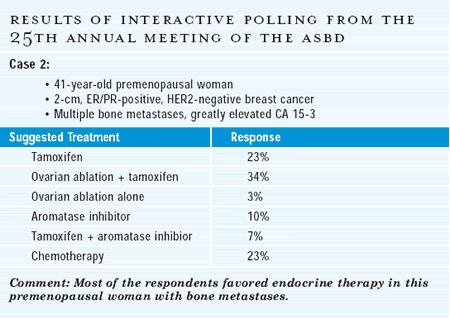| You
are here: Home: BCU 4|2001: Section 3

Section 3
Clinical Decision-Making in Metastatic
Breast Cancer
DEFINING
THE GOALS OF THERAPY
Whenever I have
a patient with newly diagnosed metastatic disease, the first thing
we talk about is not therapeutic options but goals for treatment.
Patients deserve an understanding that this is not a disease that
I can cure, so our goals are best focused on preserving the quality
of their life while still hopefully extending survival. So giving
them the most aggressive therapy with the most side effects just
doesn’t make sense to me,unless that’s going to prolong
the quantity or quality of their survival.
—Kathy
M i l l e r, MD
Medical oncologists
must remember that even if there is a therapy that causes an 80-percent
response rate, the patient is not going to be cured. Metastatic
breast cancer is a devastating disease and quality of life is a
key issue. It is important to take your time and utilize the natural
history of the disease. Some patients have very slow progression
— some bone-only patients take years to become ill. It’s
important to utilize that knowledge and have the poise not to jump
in and treat patients with a new agent for every new lesion on a
bone scan or every mild bump in tumor markers.
Our superb technology
has now led to a new phenomenon in which many women with extensive
prior therapies for metastatic breast cancer, who have a good performance
status, are off therapy, and because of a new little something on
the CT or an increase in a marker, they are looking for what to
do.
—Hyman
Muss, MD
ENDOCRINE
THERAPY
I am a very
strong believer in maximal use of hormonal therapy for women with
hormone receptor-positive,metastatic breast cancer. In premenopausal
women, I tend to use LH-RH agonists, often combined with tamoxifen.
There is also interesting data now evolving on LH-RH agonists combined
with aromatase inhibitors.26,27
—Joyce
O’Shaughnessy, MD
I would rather
have patients treated with hormonal therapies for as long as possible
and delay the need to move to chemotherapy, because it has so many
more side effects. I treat postmenopausal women with an aromatase
inhibitor as their initial therapy and then with tamoxifen as a
second-line therapy. They typically would then have a trial of megestrol
acetate as third-line hormonal therapy, assuming disease progression
is not rapid and they are not particularly symptomatic. And I still
have some patients who are treated with fluoxymesterone.
Women who are
still premenopausal at the time that their metastatic disease is
identified usually have had adjuvant tamoxifen. What we typically
do is start a gonadotropin agonist for ovarian ablation and switch
them to a specific aromatase inhibitor. You could argue in favor
of keeping the patient on tamoxifen and adding ovarian ablation,
but it just makes more sense to me to switch them to an aromatase
inhibitor, especially with the new comparison data suggesting that
the aromatase inhibitors are probably a little bit better than tamoxifen.
—Kathy
M i l l e r, MD

-
Review Select Publications
-
Review Other Clinical Trials
TRASTUZUMAB
I’m fairly
quick to get a FISH study if I see any whiff of even 1+HER2 positivity
by immunohistochemistry — just to make sure that the woman
isn’t HER2-positive. We use trastuzumab early in the course
of metastatic breast cancer, because women with FISH-positive or
3+IHC overexpressing breast cancers do very well wih it. There is
a debate about whether to give single-agent trastuzumab or combine
it with a taxane, or some would say vinorelbine. For a woman with
very limited asymptomatic disease — chest wall only, for example
— I may choose single--agent trastuzumab.
—Joyce
O’Shaughnessy, MD
We still see
many patients whose tumors were not tested for HER2 when they were
initially diagnosed, and all women with newly diagnosed metastatic
disease should have their tumors tested even if the chance of overexpression
seems quite unlikely, because there’s such a big difference
with adding trastuzumab. For the rare subset of patients who are
ER-positive and HER2 overexpressing, I still favor giving them a
trial of hormonal therapy.
Their response
rates are generally less than women who are ER-positive and HER2-negative,
but the response rates certainly are not zero. And I still would
prefer to delay intravenous therapy and chemotherapy for as long
as possible unless they’re significantly symptomatic with rapidly
progressive visceral disease.
—Kathy
M i l l e r, MD
Page
1 of 2
Next
|
